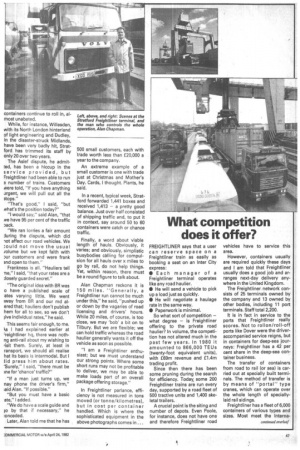Businesslike approach by terminal managers
Page 40

Page 41

If you've noticed an error in this article please click here to report it so we can fix it.
FREIGHTLINER is associated in many hauliers' minds with really big hauls; and I suppose it's at the back of some environmentalists' minds as the road-to-rail alternative transport system.
It does secure many major contracts and carries around 50 per cent of import and export traffic; it makes money by competing with road — but as an inter-modal carrier.
However, as I learned on a visit to the Stratford terminal in East London, "quite a lot of traffic just turns up at the gate".
During a long chat with the terminal manager, Alan Chapman, I discovered that, on occasion, if BR cannot handle it, he is even able to pass on a freight order to a road haulier. His choice, naturally, will be one of his good customers.
Alan is the sort of friendly northerner who soon lets you know that he comes from that part of the world (in case you have not noticed in his office the colour poster of Geoff Boycott). His background is British Rail and it gave him a good feeling to be back with BR when Freightliner returned, he said. Speaking personally, hE added that he feels there are ad vantages provided Freightline keeps its individuality as selling point. The company is re latively small, with the ability t( give personal service while re taming a family feeling amom the staff.
"This is the largest terminal with just under 200 staff, and know them all, and all the termi nal managers. I know personall) getting on for half."
Alan Chapman said they hayl a wonderful opportunity, am are left alone by BR providei they are successful. "Being northerner I watch the pennie and run the terrninal like my owl little business," he told me.
His philosophy is: don't tun anything away. He doesn't try t1 discourage unbooked — the call it "chance" or "catch" traffic. Seventy-six per cent the containers are delivered/col lected by hauliers — the resfiE) Freightliner tractive units.
Although the terminal ha been affected by the recession this is likely to have been so to ; smaller extent than to genera hauliers. After all, the importec containers continue to roll in, almost unabated.
While, for instance, Willesden, with its North London hinterland of light engineering and Dudley, in the disaster-struck Midlands, have been very badly hit, Stratford has trimmed its staff by only 20 over two years.
The Aslef dispute, he admitted, has been a hiccup in the service provided, but Freightliner had been able to run a number of trains. Customers were told, "If you have anything irgent, we will pull out all the stops."
"That's good," I said, "but ovhat's the position today?"
"I would say," said Alan, "that lye have 95 per cent of the traffic aack.
"We ran lorries a fair amount during the dispute, which did lot affect our road vehicles. We ;ould not move the usual /olume but we kept faith with Jur customers and were frank 3nd open to them."
Frankness is all. "Hauliers tell I said, "that your rates are a .:losely guarded secret."
"The original idea with BR was a have a published scale of ates varying little. We went may from BR and our md alered that; hauliers don't publish hem for all to see, so we don't live individual rates," he said.
This seems fair enough, to me. Is I had explained earlier at 'reightliner hq, there was nothng anti-rail about my wishing to fisit them. Surely, at least in ransport, we should all realise hat its basis is intermodal. But I lid press him about rates. 'Surely," I said, "there must be )ne for 'chance' traffic?"
"If a man just turns up, we nay phone the driver's firm," ;aid Alan. "If possible."
"But you must have a basic ate," I added.
"We do have a scale guide and jo by that if necessary," he ;onceded.
Later, Alan told me that he has 500 small customers, each with trade worth less than £20,000 a year to the company.
An extreme example of a small customer is one with trade just at Christmas and Mother's Day. Cards, I thought Plants, he said.
In a recent, typical week, Stratford forwarded 1,441 boxes and received 1,413 — a pretty good balance. Just over half consisted of shipping traffic and, to put it in context, say around 50 to 60 containers were catch or chance traffic.
Finally, a word about viable length of hauls. Obviously, it varies; and obviously, simplistic busybodies calling for compulsion for all hauls over x miles to go by rail, do not help things. Yet, within reason, there must be a round figure to talk about.
Alan Chapman reckons it is 150 miles. "Generally, a Freightliner run cannot be much under this," he said, "pushed up or down by the vagaries of road licensing and drivers' hours. While 20 miles, of course, is too close, we may 'bob' a bit on to Tilbury. But we are flexible; we can hold traffic whereas the road haulier generally wants it off the vehicle as soon as possible.
1 am a Freightliner enthusiast; but we must understand our strong points. Where some short runs may not be profitable to deliver, we may be able to make loads part of an overall package offering storage."
In Freightliner parlance, efficiency is not measured in tons moved (or tonne/kilometres), but in cost per container handled. Which is where the sophisticated equipment in the above photographs comes in ...


























































